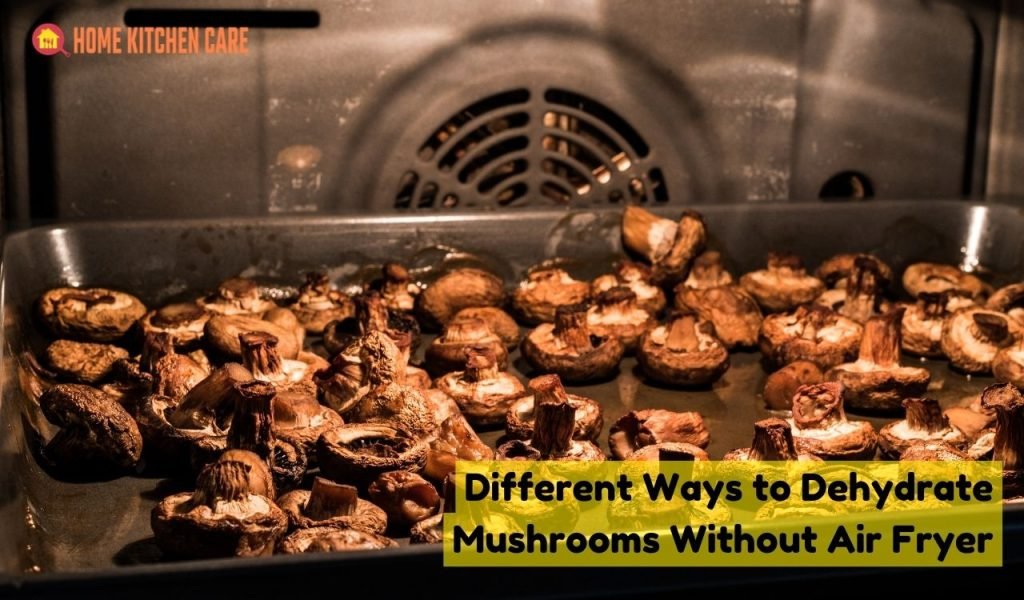Physical Address
304 North Cardinal St.
Dorchester Center, MA 02124
Physical Address
304 North Cardinal St.
Dorchester Center, MA 02124

Dehydrating mushrooms in air fryer? You bet! If you’re looking for a quick and efficient way to preserve those delicious fungi, the air fryer might just be your secret weapon. Say goodbye to lengthy drying times and hello to perfectly dehydrated mushrooms in a flash. With the air fryer’s powerful circulation of hot air, you can achieve that coveted crispy texture while locking in all the amazing flavors.
Imagine having a stash of dried mushrooms at your fingertips, ready to elevate your soups, sauces, and snacks with an intense umami punch. Get ready to unlock the magic of dehydrating mushrooms in your trusty air fryer, and let’s embark on this culinary adventure together!
Main Summary: Dehydrating Mushrooms in Air Fryer.
Dehydrating mushrooms in an air fryer is quick and easy! Slice mushrooms, place them in the air fryer, and set to low temperature. In just a few hours, enjoy crispy and preserved mushrooms for your favorite dishes. Discover a hassle-free way to extend their shelf life and savor their natural flavor!
Dehydrating mushrooms in an air fryer is a convenient and efficient way to preserve these flavorful fungi for later use. Whether you want to add them to soups, stews, or use them as a tasty snack, dehydrated mushrooms provide a concentrated burst of umami goodness. In this guide, we’ll walk you through the step-by-step process of dehydrating mushrooms using an air fryer.

Before we dive into the process, let’s gather all the necessary equipment and ingredients:
Start by selecting fresh mushrooms that are firm, with no signs of spoilage. It’s best to use mushrooms that are not overly mature or too young. Gently clean the mushrooms using a damp kitchen towel or paper towel to remove any dirt or debris. Avoid washing them under running water, as mushrooms tend to absorb water easily.
Once your mushrooms are clean, it’s time to slice them. Using a sharp knife or a mushroom slicer, cut the mushrooms into thin, even slices. Keep in mind that the thickness of the slices will affect the drying time, so try to maintain consistency.
Before placing the sliced mushrooms in the air fryer, preheat it to a temperature of 120°F (49°C). This low temperature setting will allow for gentle dehydration without cooking the mushrooms.
Spread the sliced mushrooms in a single layer on the air fryer basket or tray. Make sure they are evenly spaced and not overlapping to ensure proper air circulation. If you have a large batch of mushrooms, you may need to dehydrate them in multiple batches.
Now it’s time to start the dehydrating process. Place the loaded air fryer basket or tray into the preheated air fryer and set the temperature to 120°F (49°C). Depending on the thickness of the slices, the mushrooms will take approximately 2-4 hours to dehydrate fully.
Periodically check the mushrooms during the dehydration process to ensure they are drying evenly. You can do this by removing a few slices and testing their texture. The dehydrated mushrooms should feel dry and brittle, with no moisture remaining.
Once the mushrooms are fully dehydrated, carefully remove them from the air fryer and allow them to cool completely. This cooling process is crucial to prevent any residual moisture from causing mold during storage. Once cooled, transfer the dehydrated mushrooms to airtight containers or resealable bags. Store them in a cool, dark place away from direct sunlight.
One of the most common questions when it comes to dehydrating mushrooms is about the time it takes to achieve the desired results. While the exact duration can vary depending on several factors, such as the type of mushrooms and the thickness of the slices, the average time falls between 2 to 4 hours.

Dehydrating mushrooms is a popular method of preserving them, as it helps to extend their shelf life and concentrates their flavors. While almost any type of mushroom can be dehydrated, certain varieties are particularly well-suited for this process.
Remember to properly clean and slice the mushrooms before dehydration, ensuring even drying. Once dehydrated, store them in airtight containers in a cool, dark place for extended shelf life.
Dehydrating mushrooms is an excellent way to prolong their shelf life while intensifying their flavors. Whether you’re a forager, a mushroom enthusiast, or simply looking to incorporate dried mushrooms into your culinary repertoire, knowing how to properly store and preserve them is crucial. Let’s explore some key considerations for storing and preserving dehydrated mushrooms.
Once you’ve dehydrated your mushrooms to perfection, it’s time to think about suitable storage containers. Opt for airtight containers that provide a secure barrier against moisture and pests. Glass jars with tight-fitting lids are an excellent choice, as they prevent moisture absorption and allow you to see the contents easily.
Alternatively, you can use vacuum-sealed bags specifically designed for food storage. Whichever option you choose, ensure that the containers are clean, dry, and odor-free to maintain the quality of your dehydrated mushrooms.
To preserve the flavors and nutritional value of your dehydrated mushrooms, it’s crucial to store them in ideal conditions. The two main factors to consider are temperature and light exposure. Aim for a cool, dark place to keep your mushrooms.
Excessive heat can degrade the quality and flavor of the dried mushrooms, while prolonged exposure to light can lead to color fading. A pantry, cupboard, or cellar that maintains a consistent temperature is an ideal storage spot.
If you anticipate storing your dehydrated mushrooms for an extended period, you may want to consider freezing them. Freezing significantly prolongs their shelf life, ensuring that you can enjoy the flavors of your favorite mushrooms for months or even years.
Before freezing, make sure your dehydrated mushrooms are completely dry and sealed in airtight containers or freezer bags. It’s advisable to divide them into smaller portions, so you can thaw only what you need, minimizing exposure to moisture and temperature changes.
In addition to their rich umami flavor and culinary versatility, dehydrated mushrooms offer a range of health benefits. Let’s explore some of the key advantages of incorporating these nutritious fungi into your diet.
Dehydrated mushrooms retain a significant portion of their nutritional value, making them a valuable addition to a well-rounded diet. Mushrooms, when dried, concentrate their nutrients, including essential vitamins and minerals such as vitamin D, B vitamins, potassium, and selenium. These nutrients play vital roles in supporting immune function, bone health, energy metabolism, and antioxidant activity.
Mushrooms, both fresh and dehydrated, are renowned for their immune-boosting properties. They contain compounds like beta-glucans, which stimulate the immune system, helping it to defend against harmful pathogens and viruses. Incorporating dehydrated mushrooms into your meals can provide a natural and delicious way to support your immune system.
Dehydrated mushrooms offer a concentrated burst of flavor without the need for additives or preservatives. As the moisture is removed during the dehydration process, the natural flavors of the mushrooms become more pronounced, creating a rich and intense taste. This allows you to add depth and complexity to your dishes without relying on artificial flavor enhancers.
Dehydrated mushrooms are incredibly convenient and versatile in the kitchen. They have a long shelf life and can be easily rehydrated by soaking them in water or adding them directly to soups, stews, stir-fries, or sauces. Their concentrated flavors add a delightful earthiness to dishes, making them a popular choice among chefs and home cooks alike.
While mushrooms are generally safe for consumption, it’s important to note that some individuals may have allergies or sensitivities to certain mushroom varieties. If you have known allergies or are trying a new type of mushroom for the first time, it’s advisable to start with a small amount to gauge your body’s reaction. If you experience any adverse effects, such as digestive discomfort or skin reactions, discontinue consumption and seek medical advice if necessary.

If you don’t have an air fryer but still want to dehydrate mushrooms, don’t worry! There are alternative methods you can use to achieve great results. Let’s explore different ways to dehydrate mushrooms without an air fryer:
Oven drying is a simple and effective method to dehydrate mushrooms. Start by preheating your oven to its lowest setting, usually around 150°F (65°C). Clean the mushrooms and slice them to ensure uniform drying. Place the mushroom slices on a baking sheet lined with parchment paper, making sure they don’t overlap. Leave the oven door slightly ajar to allow moisture to escape.
Next, place the baking sheet in the oven and let the mushrooms dry for several hours, checking periodically for doneness. The drying time can vary depending on the thickness of the slices and the moisture content of the mushrooms. Stir or flip the mushrooms occasionally to ensure even drying. Once the mushrooms are dry and crisp, remove them from the oven and let them cool before storing in airtight containers.
Sun drying is a traditional and natural method of dehydrating mushrooms. This method works best in hot and dry climates. Start by cleaning the mushrooms thoroughly and slicing them into uniform pieces. Arrange the mushroom slices on a drying rack or a clean, mesh-covered surface.
Place the rack or surface in a sunny and well-ventilated area, ensuring that it is protected from dust, insects, and animals. Regularly monitor the mushrooms and bring them indoors overnight to prevent moisture absorption. Depending on the weather conditions, sun drying can take several days or even weeks. The mushrooms are ready when they become dry, leathery, and brittle. Once dried, store them in airtight containers in a cool, dark place.
Air drying is another simple method to dehydrate mushrooms, and it requires no special equipment. Begin by cleaning and slicing the mushrooms into thin, uniform pieces. Arrange the mushroom slices on a drying rack or a clean, mesh-covered surface. Ensure good airflow around the mushrooms to facilitate drying. Place the rack or surface in a dry and well-ventilated area, away from direct sunlight.
It’s important to protect the mushrooms from dust, insects, and animals during the drying process. Allow the mushrooms to air dry for several days, flipping them occasionally to promote even drying. The drying time will depend on the thickness of the slices and the ambient humidity. Once the mushrooms are completely dry and crisp, transfer them to airtight containers for storage.
Dehydrating mushrooms without an air fryer is entirely possible using alternative methods such as oven drying, sun drying, or air drying. These methods allow you to preserve the flavors of mushrooms and extend their shelf life, even if you don’t have access to specialized equipment.
Whether you choose to use your oven, harness the power of the sun, or rely on natural airflow, the key is to ensure thorough drying and proper storage in airtight containers. So, pick the method that suits your circumstances and enjoy the convenience and versatility of dehydrated mushrooms in your culinary adventures.
Yes, you can absolutely dehydrate mushrooms in your oven. Preheat your oven to its lowest setting, usually around 150°F (65°C). Clean and slice the mushrooms, ensuring uniform thickness. Place the mushroom slices on a baking sheet lined with parchment paper, ensuring they don’t overlap. Allow the mushrooms to dry in the oven for several hours, occasionally checking their progress.
Yes, you can use frozen mushrooms for dehydrating. Thaw the frozen mushrooms completely before proceeding with the dehydration process. Pat them dry with a paper towel to remove excess moisture, then slice them to ensure even drying. Follow the same dehydrating method as you would with fresh mushrooms.
If your mushrooms are not dehydrating uniformly, it could be due to uneven thickness or moisture content. To ensure even drying, slice the mushrooms into uniform thickness. Additionally, spread the slices in a single layer, making sure they don’t overlap. If some slices dry faster than others, you can remove the fully dried ones and continue dehydrating the remaining mushrooms until they reach the desired consistency.
Drying or dehydrating mushrooms is an excellent preservation method that allows you to enjoy their flavors and extend their shelf life. Removing moisture from mushrooms inhibits the growth of bacteria, mold, and yeast, preventing spoilage.
Additionally, dehydrated mushrooms are compact and lightweight, making them convenient for storage and transportation. They can be rehydrated and used in various dishes, adding an intense umami flavor.
To determine if your mushrooms are fully dehydrated, check for dryness, crispness, and brittleness. Dehydrated mushrooms should be dry to the touch, with no moisture remaining. They should feel crisp and brittle, easily breaking when bent. The mushrooms should no longer feel leathery or pliable. Conduct a taste test as well – properly dehydrated mushrooms will have a concentrated flavor.
When stored properly in airtight containers in a cool, dark place, dehydrated mushrooms can last for several months to a year. However, it’s important to regularly check for signs of moisture or mold growth. The quality and shelf life of dehydrated mushrooms may vary depending on factors such as drying method, storage conditions, and initial moisture content.
The ideal temperature for dehydrating mushrooms is generally between 125°F and 135°F (52°C to 57°C). This low temperature helps to preserve the flavors and nutrients while slowly removing the moisture from the mushrooms. Adjust the temperature based on your specific oven or dehydrator model, and follow the manufacturer’s instructions for optimal results.
Before dehydrating mushrooms, start by cleaning them thoroughly. Gently brush off any visible dirt or debris and trim the stems if needed. Avoid soaking mushrooms in water, as they are porous and can absorb excess moisture. Instead, wipe them with a damp cloth or paper towel. Slice the mushrooms to a consistent thickness, ensuring that all pieces are roughly the same size. This will help promote even drying and prevent some slices from drying faster than others.